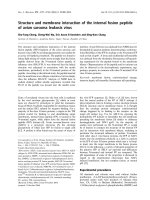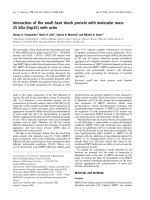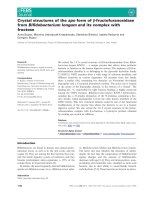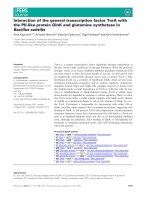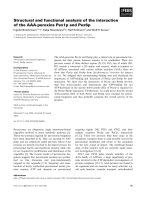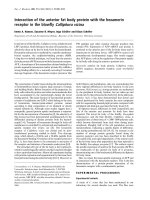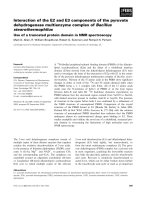Interaction of the elements characterizing the quadratic nonlinearity and forced excitation with the other excitations
Bạn đang xem bản rút gọn của tài liệu. Xem và tải ngay bản đầy đủ của tài liệu tại đây (2.78 MB, 9 trang )
lí Cơ học Journal of Mechanics, NCNST of Vietnam T. XIX, 1997, No 4 (11 - 20)
IN T E R A C T IO N OF T H E E L E M E N T S
C H A R A C T E R IZ IN G T H E Q U A D R A T IC
N O N L IN E A R IT Y A N D FO R C E D
EXCITA T IO N W IT H T H E O T H E R E X C IT A T IO N S
N guyen Van D ao
Vietnam National University, Hanoi
oduction
In nonlinear systems, the first order of smallness terms of quadratic nonlinearity and the
id excitation with nonresonance frequency and the second order of smallness terms of linear
ion, cubic nonlinearity, forced and parametric excitation with resonance frequencies have no
:t on the oscillation in the first approximation. However, they do interact one with another in
second approximation and new nonlinear phenomena occur. The study of these phenomena,
ig the asymptotic method of nonlinear mechanics [ 1Ị with a digital computer, is our aim.
Interaction between the elements of quadratic nonlinearity and forced excitation
imselves
Let us consider a nonlinear system governed by the differential equation
X + X = e\ctx2 + q COS 2 <p (t)] — £2(2hx + fix 3), (1 * 1 )
.ere th e d o ts in d ic a te d if fe re n tia tio n w i th re s p e c t t o tim e , a, q, h a n d fi are c o n s ta n ts , T = et
d e is a small dimensionless parameter characterizing the smallness of the terms behind it. The
rameter £ is introduced artificially and used as a book-keeping device and will be set equal
unity in the final solution. The quadratic term may be due to curvature or and asymmetric
aterial nonlinearity. The function <p(r) is supposed to be a form
~^ = " (r)> r = e i> (L2)
here u(t) is close to the natural frequency i.e. to unity:
v2(r) = 1 + e2 A(r). (1.3)
'he equation (1.1) can be rewritten as:
X + i/2(r)x = e [ a x 2 + q COS 2< p(r)] — S2( - A z + 2h i + fix3). (1 .4 )
A Solution of this equation is sought by using the asymptotic method of nonlinear oscillation
X = acos Ớ-f-t/>, ớ) + e2u2(a, t/;, Ớ) + 53 . . ., 9 = ip + rj)} (1.5)
1]
11
= ~~zi~ + ( f ~ 7a2) +/l2<j2' e2A = w2 - 1 « 2(w - 1), 7 = £ 0 - • (1.16)
Vom equation (1.15) it follows that:
7a2 * w - l ± y ^ f - - ^ . (1.17)
dependence of the amplitude a on the external frequency UJ is presented in figure 1 for the
neters: e2aq = 0.063, e2h = 0.01, £27 = 0.08.
The stability of nontrivial stationary solutions (a Ỷ 0) of the equation (1.12) when UJ is constant
)e studied by using the corresponding variational equations, which lead to the condition: [l|
dW
p > 0. 1.18
da0
.use function w (1.16) is positive outside and negative inside the resonance curve, the stable
ch of the resonance curve is the upper branch, which corresponds to the upper sign before the
:al in ( i . 17). Thus, between the two forms of oscillations corresponding to definite values of
fie form with large amplitude is stable and the form with small amplitude is unstable.
Fig. 1
Following Chapter 4 of [l], the trivial solution a = 0 of the equation (1.12) is stable if the
lue L0 does not lie in that interval of the axis U/, from which the resonance curve is rising. In
;ure 1 the stable branches are shown by heavy lines, while the unstable ones are shown by dotted
The passage of the system under consideration through resonance when v(t) is not a constant,
it changes by the law: z/(r) = Uo+Sfit, can be examined by integration of the differential equations
12). The parameters are chosen as to = 0, do = 0.009, t/>0 = 0, e2h = 0.001, e27 = 0.01,
:ctq = —0.024, V0 = 1, /1 = 10-5 (curve 1, Fig. 2); /1 = 2- 1Q~5 (curve 2, Fig. 2); /1 = -1 0 -5
:urve 1, Fig. 3); /1 = - 2 10~6 (curve 2, Fig. 3).
13
a
a
a 030
0.02
0.020 -
0.010
0000
too
0.97
0.99
Ì)2
Fig. 2
Fig. $
From the expression (1.12) and (1.13) one can see that the quadratic nonlinearity (a) is always
to aoftenize the system under consideration regardless of the sign of Q. Moreover, two elements
characterizing quadratic nonlinearity a i 2 and forced excitation qcos2<p(r) combine together and
act just like a parametric excitation with an intensity aq.
The system of equations (1.12) has a trivial solution a = 0, which corresponds to a pure forced
oscillation under the action of an external excitation eqcos2<p:
2. Interaction between the elements of quadratic nonlinearity and forced excita
tions
The system under consideration in this paragraph is governed by d.e.
X -f 0J2x = f ( a i 2 + q cos 2ujt) + f 2[A i — 2hi — /?x3 + r cos(u;i — r?)], CJ2 = 1 + e2A. (2.1)
Here, the nonresonance forced excitation (<?) is of the first order of smallness, while the resonance
forced excitation (r) is of second order of smallness. These excitations have no effect on the oscil
lation in the first approximation, but they interact one with another in the second approximation.
Similarly to the previous paragraph, the solution of the equation (2.1) is found in the series (1.5).
The equations (1.11)-(1.13) now take the form:
(1.19)
X = a cos
2 ị a
0 + ff|
(ocá2 -I- 2a cos 2t/>i COS 26 — - sin 2rp sin 201, 6 = 0Jt + \p, (2-2)
(2.3)
14
8 12
The stationary solutions of equations (2.3) are determined by the relations:
f o = 0, go = 0,
<ỵq
/ o = 2hua
1 asin 2 0 + r sin(i/> + rj),
3
<7o = Aa — 2 7 a 3
- a c o s 2 t / > 4- r cos(rp -f 77),
ỉquivalently:
m here we obtain
/0 cos rị) — (70 sin 0 = 0 , /0 sin Tp + <70 c°s 0 = 0.
2/iu>a cos tp — (Aa — 27a3 + — a) sin t/> -f r sin rj = 0,
3
2/itưa sin rp + (Aa — 27a3
-a ) CO S rp + r COS rj = 0.
Ổ
)te: The equations (2.4) belong to the form
Y sin rịỉ + z cos t — c.
le functions sin \ị) and COS yịỉ satisfy the relationship
sin2 1p + cos2 0 = 1.
om equation (1) we have
Y 2 sin2 rp = c 2 + z 2 COS2 rp — 2z c COS rp.
liminating sint/> between last two equations we get
(Y 2 Hr z 2) COS2 yị) - 2 Z C COS yị> + c 2 - Y 2 = 0 .
b m here we obtain
= y2 l ' z2 [zc ± V F C P - (ya + Z2)(C3 - n
COS
Therefore, the condition for reality of costịỉ is that the under radical expression should
legative:
y 2 + z 2 > c 2.
Applying the condition (2.5) to equations (2 .4 ) we have
a2 1 4h2w2 -f - 27 a2 + j > f2 sin2 *?>
a2 |4 / i2cư2 + (A - 27a2 - I > r2 COS2 rj.
S yste m w ith o u t frictio n (/i = 0)
In this case equations (2 .4 ) take the form
27 a2 -
( * ♦ ? ) ]
2 7 a2 —
( * - 3 )]
a sin = — r sin Ĩ7,
a cos \p = r cos T).
(2.8)
a) If 27 a2 - ^ # 0 and 27 a2 - ^ 7*^ 0 then eliminating the phase xp from (2.8)
we get the equation of the resonance curve C\\
w (u;2 , a2) = 0.
where
=
rl ™ L l
+
t fgfl??
[ 2 V ( a + ^ ) ] [2^ - ( a - f ) ]
b) If 2 7 a2 — -f ^ j = 0, i.e. if we have the resonance curve c 2:
— a
then
From here we obtain:
2 aq
o.a. sin yp = — r sin rj,
a COS v> = r COS r?.
Ó
±3r 2 9 r2
sin T) = 0 => ỴỊ = 0, 7r; cos T7 = ± 1 => w = a rc COS
=> a > - — — -
7 2a<?a 4 c * v
If 27a2 — ^ = 0, i.e. if we have the resonance curve C3:
2V = u,2 - 1 - ^ ,
3
then
, _ 2a<? , .
o.acos yp = rcosrj, -7— a sin rp = r sin r?
o
Prom here we obtain:
cos rj = 0 => TỊ = — , — ; sin r? = ±1 => t/; = ±arc sin — => a* >
7T 3tt . 3r 2 9r2
(2.9)
(2 . 10)
(2 .11)
( 2. 12 )
(2.13)
(2.14)
2 2 ' ' 2aọa 4 a 2g2
So, if rj = 0, — , 7T, — , the resonance curves c 2» C3 do not exist. If rj = 0, 7T, then beside the
2 2
9 r
resonance curve Cl there is still semi-straight line C2 in the (a2, cư2)-plane with a2 > ^—2 2 . If
^ _ 7T 3tt kken beside the resonance curve Cl there is still semi-straight line C3 in the (a2,u;2)-
2 2
9r2
plane with a2 > ■ õ Õ ■
4org*
S ystem w ith friction (/1 ^ 0)
Solving the system of equations (2.4) relatively sin \ị) and COS rp we have:
16
• / — I — P i (o 1
a sin rị) = acost/; = - ~ , (2.15)
>r the case D 7^ 0:
D = 4w2h2 + (A — 2 7 a2 ) 2 — a — ,
D i = —r 2/icj sin rj + — 2 7 a2 + — ^ COS ?7j , (2.16)
2hoj cos TỊ — — 27 a2
sin r/j.
Di = -1
ninating 0 from (2.15) gives the following equation for amplitude (a) and frequency (u>)
fr lT l
[f D - 0 we have
27a 2 = cư2 — 1 ± y — —4a;2/i2 , (2-1 8)
1 sin 0 , cos tịỉ exist only when Di = D2 = 0, or equivalently
D\ cos Y] — D2 sin rj = 0, Di sin rj + D2 cos = 0.
Dm here we obtain:
= cư* — 1 -f — cos 2rj, CJ* =
sin 277. (2.19)
3 6/1
le formula (2.6) with taking into account D = 0 and (2.19) gives a restriction to a*:
* Ê Ệ ■ «2-20'
. Interaction of the elements of first d e g r e e of smallness quadratic nonlinearity
nd fo rced e x c ita tio n w ith the self-excita tion of second degree o f sm a llness
Let us consider a nonlinear system described by the following differential equation:
X -I - (Jj2x = e ( a x 2 + qcos 2ut) + e2 [Ax + D(l — ỏx2)x — /33x] ,
u>2 = 1 — £2A. 3,1
Vherc ũ , Ỗ are positive constants. The other parameters are the same as in the previous para-
ra p h s .
The approximate solution of the equation (3.1) will be found in the form (2 .2 ) with the
unpiitude (a) and phase (v>) satisfying the relations:
Ỳ t = è [ D a u j ( 1 ~ ì a 2 ) + f asin24
da
£
dt 2(jj
drp e2
a dt =
2 UJ
(3.2)
17
where
3/? 5q2
7 - 1 12
Equation (3.2) have a trivial solution a = 0. The non-trivial (a Ỷ 0) stationary amplitude do
and phase t/>0 are determined from the equations:
~ sin 2 \Ị>0 = - D u ịl - -a^J ,
CtQ n
— COS 2rpo = A — 27ỮQ.
3
(3.3)
Eliminating the phase \po gives:
w (d o , w 2 ) = 0,
w(a0,w 2) = (A - 27 ag)2 + D2W2 ( l - - ?-f-
(3.4)
(3.5)
From the last two equations we obtain approximately
u>2 = 1 + 2c27 al ± e2 yj - D2 ( ĩ -
(3.6)
This formula is plotted in the figure 4 for the parameters: E2D = 10 3, 6 = 40, e-Ệ = 10 3 and
£2Tr = —0.005 (curve l), 527 = 0.01 (curve 2) and e2r) = 0.025 (curve 3)
t o o *
Denoting the right kand sides of the equations (3.2) by X and y, respectively, we have:
/ d X \ e2 _ r o fd X \ e2a0 , 2\
( a ) = - T ữ(5aồ’ IT T = (A “ 2^ )
V 3a / 0 4 V d\p / 0 CJ
( d Y \ 2e2 2 2 / Ố 2\
( * r ) o ( ^ ) o = cao jD ( 1 4 ° °)’
18
(3.7)
the subscript “0” means that the derivatives are calculated at stationary values do, y>0 (3.3).
tability conditions of stationary oscillations are
““ ( f f ) o + ( a * ) o = ,2“oD( 1 - 2°«) < °'
/
d X \ fdY_\
_ /
dX_\ f dY_\
g 4 3
dW
V (
3
a / 0 V
d\p
/ 0 \ <
9
t/> / 0 V d a / 0
2uj2
0
dáị
(3.8)
e ao > 0, the stability conditions take the form
2 2
àị > T
(3W
da*
> 0. (3.9)
To study the stability of the zero solution a = 0 of equations (3.2) we introduce the variable
connected with a and rp by the relations: .
u = acosự>, V = asinrp. (3.10)
have
2 LU
.2
(3.11)
da
dt
dv S'
st 2(jj
‘re the non-written terms contain u and t; with higher degrees of smallness. The origin u = V = 0
= 0) of the system of equations (3.11) is unstable, because the characteristic equation of the
ar terms of (3.11) has the roots with positive real part.
In the figure 4 the stable branches of resonance curves are shown by heavy lines, while the
itable ones-by dotted lines.
Conclusion
In the nonlinear system under consideration, the elements characterizing the first degree of
allness quadratic nonlinearity and nonresonance forced excitation (for brief, N-F-elements) have
e f f e c t on the oscillation in the first approximation. However, they interact one with another in
Ỉ second approximation and appear as a parametric excitation with modulation of the product of
eừ intensity (a, <7). This means that each element (a and q) standing alone has no effect on the
3tem and these elements have equal role. The resonance curve (Fig. 1) is bent to the right and
ts the frequency-axis at two points. This curve is typical for a nonlinear system with parametric
citation. The passage of the system under consideration through resonance has been examined
’ig-2, 3).
In the second paragraph theừ interaction between these elements and the second degree of
uallness resonance forced excitation has been studied. Some typical results for the interaction
2tween parametric and forced excitations have been obtained. The interaction between N-F-
ements and self-excitation is given in the paragraph 3. The resonance curves have oval forms
Fig. 4) and are bent either to the left or to the right, depending on the sign of the parameter 7 .
Acknowledgments
TỈDe author is grateful to Dr Tran Kim Chi for numerical calculations on the digital computer,
work was financially supported by the Council for Natural Sciences of Vietnam.
19
REFERENCES
1. Mitropolskii Yu. A., Nguyen Van Dao. Applied asymptotic methods in nonlinear oscillations.
Kluwer Academic Publishers, 1997.
2. Nguyen Van Dinh. Interaction between parametric and forced oscilations in fundamental
resonance. J. of Mechanics, NCNST of Vietnam, Tom 17, No. 3, 1995.
Received October 15, 1997
TƯƠNG TÁC CỦA CÁC PHAN TỬ ĐẶC TRƯNG CHO PHI TUYEN CAP HAI
VÀ KÍCH ĐỘNG CƯỠNG BỨC VỚI CÁC KÍCH ĐỘNG LOẠI KHÁC
Trong các hệ phi tuyến, những số hạng phi tuyến cấp hai và kích động cưỡng bức không cộng
hưảng có bậc bé e và các số hạng ma sát tuyến tính, phi tuyến cấp ba, các kích động thông số
và cirỡng bức cộng hưởng có bậc bé é2 sẽ không có tác dụng trong xẩp xỉ thử nhất, song chúng
tác động qua lại với nhau trong xẩp xi thử hai và những hiện tượng phi tuyến mới sẽ xuất hiện.
Việc nghiên cứu các hiện tircmg này là mục tiêu của bài báo. Phưcmg pháp tiệm cận của cơ học
phi tuyến kết hợp với máy tính đã cho phép giải bài toán đặt ra.
20

